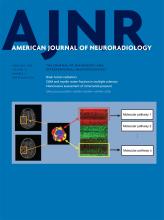Abstract
BACKGROUND AND PURPOSE: Hematoma expansion is an independent determinant of poor clinical outcome in intracerebral hemorrhage. Although the “spot sign” predicts hematoma expansion, the identification requires CT angiography, which limits its general accessibility in some hospital settings. Noncontrast CT, without the need for CT angiography, may identify sites of active extravasation, termed the “swirl sign.” We aimed to determine the association of the swirl sign with hematoma expansion.
MATERIALS AND METHODS: Patients with spontaneous intracerebral hemorrhage between 2007 and 2014 who underwent an initial and subsequent noncontrast CT at a single center were retrospectively identified. The swirl sign, on noncontrast CT, was defined as iso- or hypodensity within a hyperdense region that extended across 2 contiguous 5-mm axial CT sections.
RESULTS: A total of 212 patients met the inclusion criteria. The swirl sign was identified in 91 patients with excellent interobserver agreement (κ = 0.87). The swirl sign was associated with larger initial hematoma (P < .001) and earlier initial CT (P < .001) and hematoma expansion (P = .028). Multivariable regression modeling demonstrated that if one assumed similar initial hematoma volume, onset-to-first scan, and time between CT scans, the median absolute hematoma growth was 5.77 mL (95% CI, 2.37–9.18 mL; P = .001) and relative growth was 35.6% (95% CI, 18.5%–52.6%; P < .001) higher in patients with the swirl sign compared with those without.
CONCLUSIONS: The NCCT swirl sign was reliably identified and is associated with hematoma expansion. We propose that the swirl sign be included in risk stratification of intracerebral hemorrhage and considered for inclusion in clinical trials.
ABBREVIATIONS:
- ICH
- intracerebral hemorrhage
- IQR
- interquartile range
- © 2018 by American Journal of Neuroradiology












